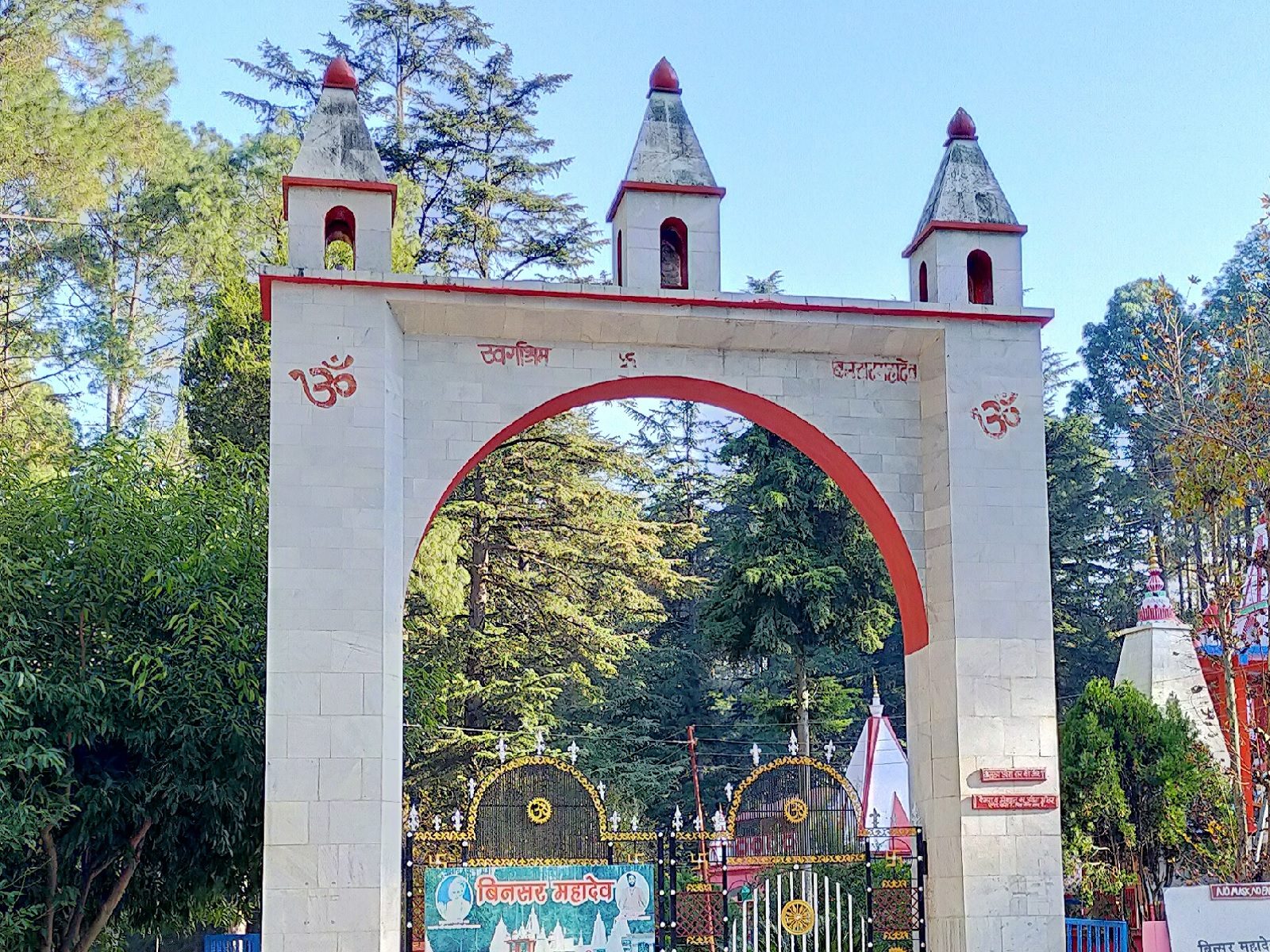Tucked away in the dense oak and deodar forests of the Kumaon Himalayas, at an elevation of 2,032 meters (6,667 feet), lies a centuries-old Shiva temple known as Binsar Mahadev Temple. Located within the Binsar Wildlife Sanctuary, just 35 kilometers from Almora town, this temple is not merely a place of worship—it is a convergence of nature, history, and devotion.
Unlike the bustling pilgrimage centers of Kedarnath or Badrinath, Binsar Mahadev remains serene, secluded, and deeply rooted in the cultural fabric of Kumaon. It stands as a silent witness to the region’s royal past, nestled in a landscape that once served as a summer retreat for the Chand kings.
This article presents a truthful, comprehensive, and research-based account of Binsar Mahadev, Almora—covering its history, architecture, religious significance, ecology, conservation, and cultural role—based on verified sources and documented traditions.
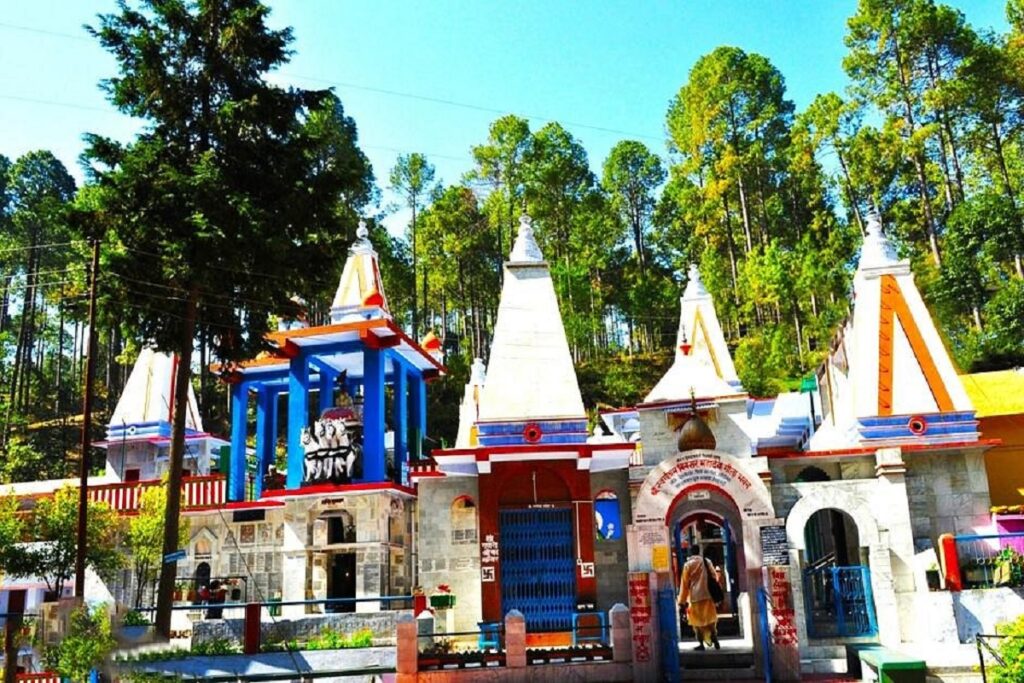
Location and Geography: In the Lap of the Himalayas
Where is Binsar Mahadev?
- District: Almora, Uttarakhand
- Nearest Town: Almora (35 km)
- Coordinates: 29.6324673° N, 79.3378366° E
- Altitude: ~2,032 meters (6,667 ft)
- Region: Binsar Wildlife Sanctuary, Western Himalayas
(Source: Survey of India Topographic Maps; Uttarakhand Tourism Department)
The temple lies in the central ridge of the Binsar massif, surrounded by dense temperate forests and offering uninterrupted views of the Himalayan snow range. It is located near Zero Point, one of the most famous viewpoints in Kumaon, from where Nanda Devi, Trishul, Panchachuli, Nanda Kot, and other peaks are visible on clear days.
The Kosi River basin drains this region, with numerous springs and streams feeding into it. The Mankhet and Ramgarh valleys lie to the west and south, contributing to the area’s rich hydrology.
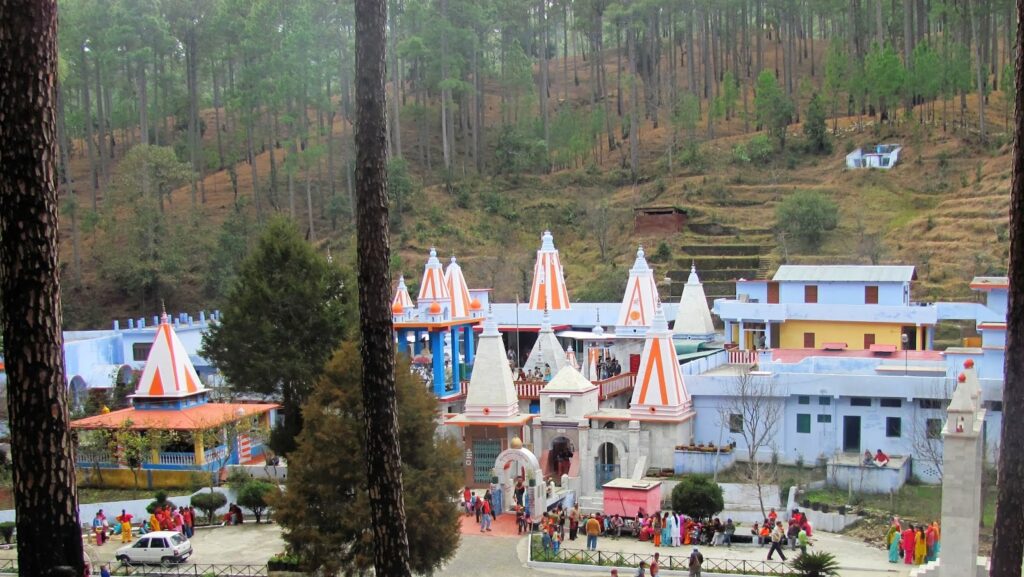
Geological Setting
The region is part of the Lesser Himalayas, characterized by folded sedimentary rocks, including phyllites, quartzites, and slates. The tectonic activity in this zone has created steep ridges and deep valleys, making the terrain both dramatic and ecologically diverse.
The soil is rich in organic matter, supporting lush vegetation. The slope stability is moderate, though landslides occur during heavy monsoon rains.
Historical Significance: The Legacy of the Chand Dynasty
The Chand Kings and Binsar
The Chand dynasty ruled over Kumaon from the 7th century CE until the 19th century, with capitals at Champawat and later Almora (founded in 1563 by King Tej Chand).
Binsar was one of the favorite summer retreats of the Chand rulers, who built royal lodges and gardens here to escape the heat of the plains. The cool climate, fresh air, and panoramic views made it an ideal royal sadan (residence).
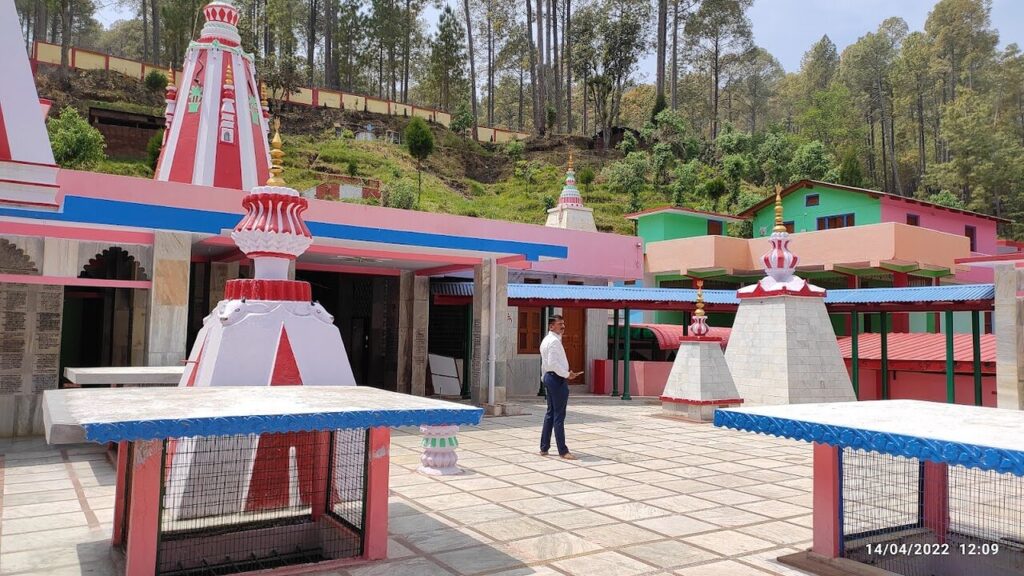
According to “History of the Panwar Rajputs” by Harish Dutt Dev (1934) and Uttarakhand State Archives:
“The kings of Almora used to spend the summer months in Binsar, where the climate was cool and the forests rich with game.”
While no royal palace remains today, the ruins of stone foundations, ancient pathways, and water channels can still be seen in the area. Local elders recall stories of royal processions and fire-lit ceremonies held in the forest.
The Temple’s Origins
The exact date of construction of Binsar Mahadev is unknown, but architectural and stylistic evidence suggests it was built between the 10th and 12th centuries CE, during the height of the Katyuri and early Chand periods.
The temple is not mentioned in major Puranas, but it is referenced in local sthala-puranas and Chand-era records as a sacred site where kings performed rituals for rajyabhishek (coronation) and shanti yajna (peace ceremonies).
It is believed that the temple was established to seek Shiva’s blessings for the kingdom’s prosperity and protection.

Temple Architecture: A Classic Example of Katyuri Style
The Binsar Mahadev Temple is a fine example of medieval Kumaoni temple architecture, reflecting the Katyuri style that flourished in the region between the 7th and 11th centuries CE.
Key Architectural Features:
- Material: Local grey stone and slate
- Roof: Pyramidal slate roof (typical of Katyuri temples)
- Garbhagriha (Sanctum): Houses a black stone Shiva Lingam
- Mandapa (Hall): Small, pillared structure for devotees
- No Shikhara: Unlike North Indian temples, it lacks a towering spire
- Orientation: Faces east, allowing morning sun to illuminate the deity
(Source: Indian Temple Architecture: Form and Transformation by M.A. Dhaky)
The temple is modest in size, blending harmoniously with the forest. It lacks elaborate carvings, reflecting the austere, functional aesthetic of Himalayan folk temples.

Construction Techniques
- Walls built with dry-stone masonry (no mortar)
- Roof supported by wooden beams and covered with slate tiles
- Floor paved with flat stone slabs
- Natural drainage system to prevent waterlogging
These techniques are climate-adaptive, designed to withstand snow, rain, and seismic activity.
Comparison with Other Katyuri Temples
| Period | 10th–12th c. CE | 13th c. CE | 7th–13th c. CE |
| Roof | Pyramidal slate | Pyramidal slate | Pyramidal slate |
| Carvings | Minimal | Elaborate | Moderate |
| Location | Forested hill | Riverbank | Sacred grove |
✅ Conclusion: Binsar Mahadev is a simpler, rural variant of the Katyuri style, likely built for local and royal use, not mass pilgrimage.
Religious Significance: Lord of the Forest
The deity is worshipped as Binsar Mahadev—a form of Lord Shiva—and is considered a kuldevta (family deity) by many Kumaoni Brahmin and Rajput families.
Local Beliefs
- The temple is believed to be self-manifested (svayambhu) or established by a sage in ancient times.
- It is said that Shiva appeared here in a vision to a Chand king, blessing him with victory in battle.
- Locals believe that prayers at Binsar Mahadev are quickly answered, especially for health and protection.
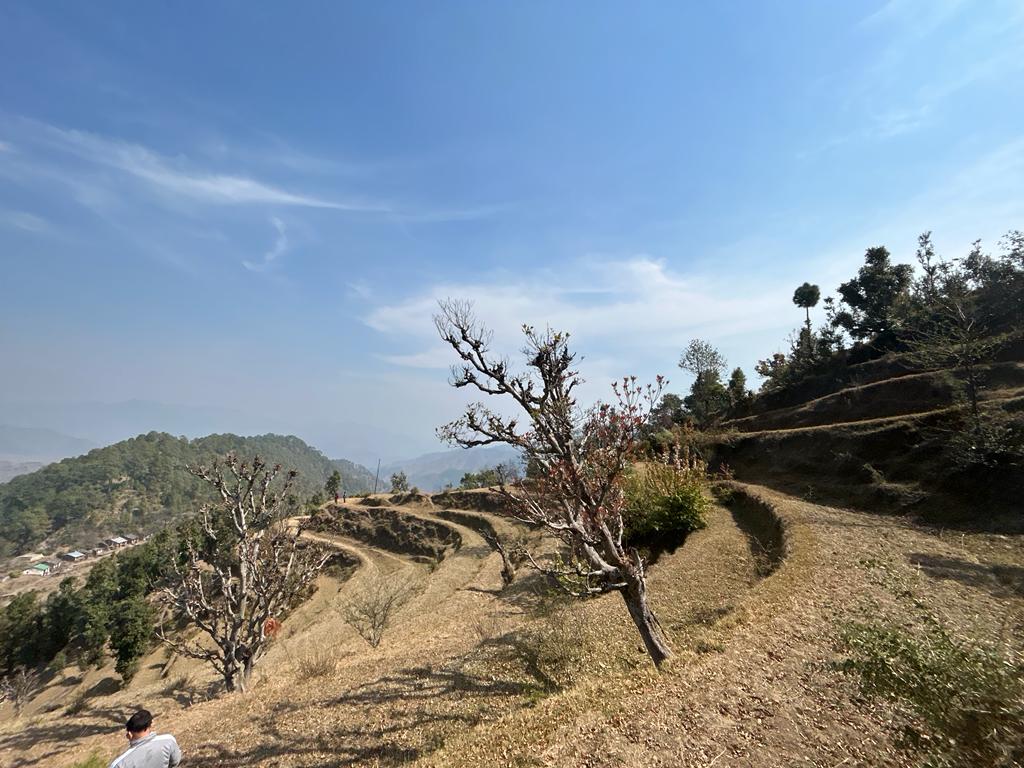
Rituals and Worship
- Managed by local pandas (priests) from hereditary families.
- Daily puja includes:
- Abhishekam with milk, water, and bel leaves
- Dhoop and diya offerings
- Shankh naad (conch blowing)
The lingam is bathed twice daily—morning and evening—with water from a natural spring nearby.
Festivals Celebrated
- Maha Shivratri (February/March):
- Main festival of the year.
- Devotees from Almora, Binsar, and nearby villages gather.
- Night-long jagran, bhajans, and aarti.
- Special havan performed.
- Pilgrims offer bhang, milk, and datura flowers.
- Somvar Vrat (Mondays of Shravan):
- Women observe fasts and offer jal (water) to the lingam.
- Many walk the 2-km trek barefoot.
- Nag Panchami:
- Offerings made to snakes, as Shiva wears a serpent.
- Milk and flowers placed near rock crevices.
(Source: Almora Temple Committee; Uttarakhand Tourism)
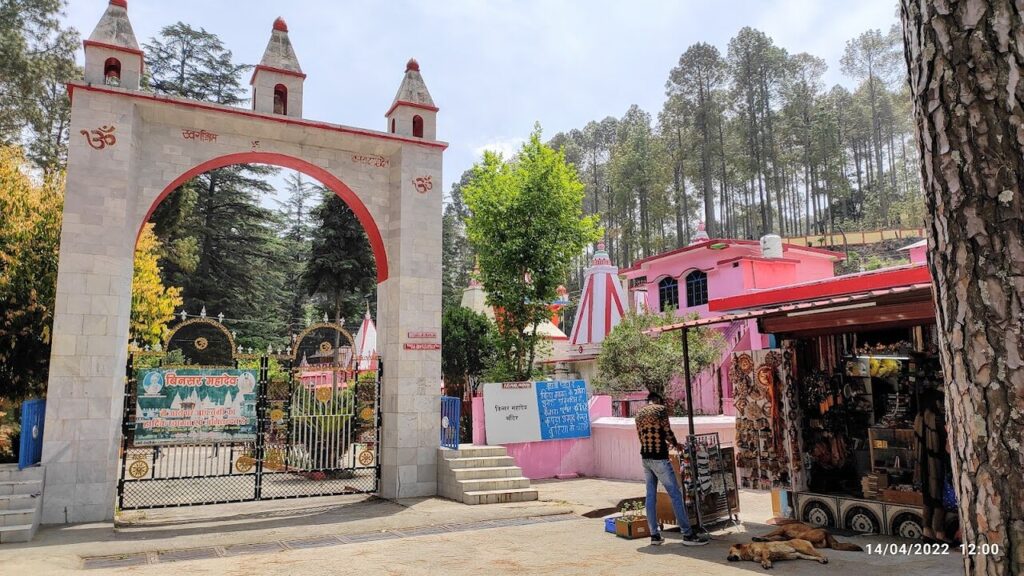
Ecology: A Sanctuary of Biodiversity
The Binsar Wildlife Sanctuary is one of the richest temperate forest zones in the Indian Himalayas.
Flora
- Dominant Species:
- Deodar (Cedrus deodara) – Sacred, long-lived
- Rhododendron (Rhododendron arboreum) – Blooms in red (March–April)
- Oak (Quercus leucotrichophora) – Supports diverse fauna
- Himalayan Birch (Betula utilis) – Bark used in traditional medicine
- Understory: Ferns, mosses, lichens, medicinal herbs like atish, kutki, ban senna
(Source: State of Forest Report 2021, Forest Survey of India)
Fauna
The sanctuary is home to:
- Mammals: Leopard, Himalayan black bear, barking deer, goral, langur
- Birds: Himalayan monal (state bird), koklass pheasant, woodpeckers, eagles
- Reptiles: Himalayan pit viper, garden lizard
The Uttarakhand Forest Department has implemented strict conservation measures, including:
- Ban on logging
- Plastic-free zone
- Controlled tourism
- Camera traps for leopard monitoring
(Source: Binsar Wildlife Sanctuary Management Plan, 2020)
Tourism and Pilgrimage: A Growing but Controlled Flow
Visitor Footfall
- Annual pilgrims: ~3,000–5,000
- Tourists: ~10,000 (mostly domestic)
- Peak Season: Maha Shivratri, May–June, September–October
(Source: Almora District Tourism Office, 2023)
How to Reach
- By Road:
- Nearest city: Almora (35 km)
- Road from Almora to Binsar is motorable but narrow
- Last 2 km to the temple is a foot trail
- By Air: Jolly Grant Airport, Dehradun (190 km)
- By Rail: Kathgodam (125 km)
- Trek: 2 km from Binsar main viewpoint
Facilities
- Dharamshala (pilgrim rest house)
- Toilets and drinking water
- No commercial shops—preserving serenity
- Forest rest house for tourists (booked via Uttarakhand Forest Department)
Conservation and Challenges
Threats
- Littering: Despite rules, some tourists leave waste.
- Landslides: Common in monsoon due to fragile slopes.
- Unregulated Construction: A few private lodges have been built illegally.
- Climate Change: Erratic rainfall affects forest health.
- Human-Wildlife Conflict: Leopards occasionally venture near trails.
Protection Measures
- Managed by Uttarakhand Forest Department and Almora Temple Trust
- No loudspeakers allowed near the temple
- Plastic banned in the sanctuary
- Eco-development committees involve locals in conservation
- Awareness campaigns on responsible tourism
Cultural and Literary References
In Literature
- Mentioned in “The Himalayan District of Kumaon” by J.H. Batten (1884) as a “quiet shrine in the forest.”
- Referenced in Devdutt Pattanaik’s “Temple Tales of Kumaon” (2017) as a symbol of nature-worship synthesis.
In Media
- Featured in Outlook Traveller (2020): “Binsar: Where the Gods Still Walk.”
- Covered by Doordarshan in a documentary on Himalayan temples.
In Folklore
- A local legend says a sage meditated here for 12 years, and Shiva appeared to him.
- Another tale claims the lingam grew slightly every year, though no measurement confirms this.
Why Binsar Mahadev Matters
1. A Symbol of Harmony
The temple embodies the Kumaoni ideal of dev-van (god-forest)—where nature and divinity are inseparable.
2. A Living Heritage
Unlike museums, this is a functioning temple, where tradition, ecology, and community coexist.
3. A Model for Sustainable Pilgrimage
With low footfall, no commercialization, and strong conservation, Binsar Mahadev offers a blueprint for eco-spiritual tourism.
4. A Site of Historical Continuity
It connects the Chand dynasty’s legacy with present-day devotion, serving as a living archive of Kumaon’s spiritual history.
FAQs on Binsar Mahadev Temple, Almora
Q1. Where is Binsar Mahadev Temple located?
A1. Binsar Mahadev Temple is located in the Almora district of Uttarakhand, surrounded by thick deodar and pine forests at an altitude of about 2,480 meters.
Q2. Who built Binsar Mahadev Temple?
A2. The temple is believed to have been built in the 9th or 10th century by King Kalyan Chand of the Chand dynasty.
Q3. Which deity is worshipped at Binsar Mahadev Temple?
A3. The main deity is Lord Shiva, worshipped here as Binsar Mahadev.
Q4. Why is Binsar Mahadev Temple famous?
A4. It is famous for its ancient stone carvings, spiritual significance, and serene natural surroundings that make it a peaceful pilgrimage spot.
Q5. How far is Binsar Mahadev Temple from Almora town?
A5. The temple is about 19 km from Ranikhet and 70 km from Almora, easily accessible by road.
Q6. Is there any trekking route to Binsar Mahadev Temple?
A6. Yes, visitors often enjoy a short forest trek through dense deodar trees to reach the temple, making the journey scenic and adventurous.
Q7. What is the best time to visit Binsar Mahadev Temple?
A7. The best time is from March to June and September to November when the weather is pleasant and the forests are lush.
Q8. Are there any festivals celebrated at Binsar Mahadev Temple?
A8. Mahashivratri is celebrated with great devotion, attracting a large number of devotees from nearby villages and towns.
Q9. Is accommodation available near Binsar Mahadev Temple?
A9. While there are limited stay options near the temple, visitors usually stay in Almora, Ranikhet, or Binsar Wildlife Sanctuary resorts.
Q10. What else can visitors explore near Binsar Mahadev Temple?
A10. Visitors can explore Binsar Wildlife Sanctuary, Kasar Devi Temple, Jageshwar Temples, and other scenic spots around Almora.

